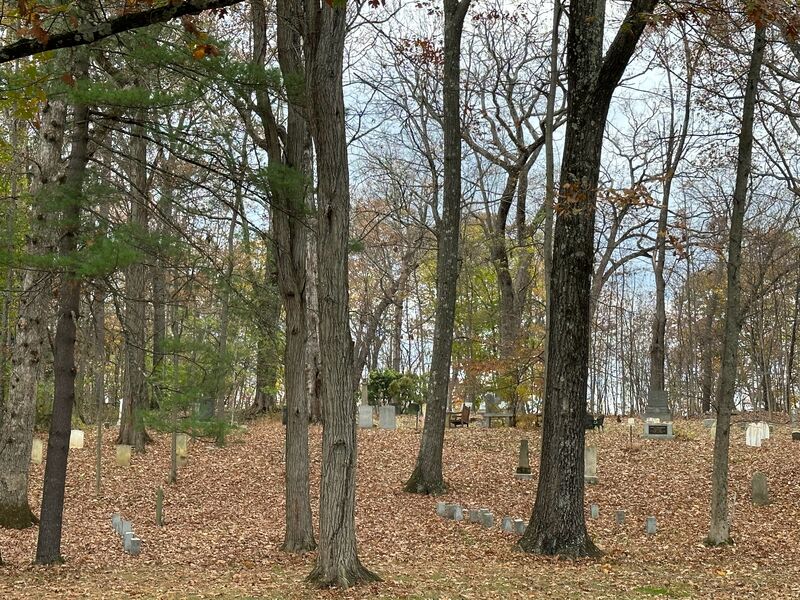by Gretchen Lytle
Introduction
Just to the north of Faculty Circle, nestled in the woods around the hillside of outcroppings, is the Bard cemetery. It’s a lovely, peaceful area for a walk and contemplation, with places to sit along the way. To get there, walk north on the Main Campus up the pathway that runs between the Stevenson Library and the President’s House. Look just past the parking area at the top, and walk down to enter through the Lych Gate, the roofed gateway where a bier might have been settled for the first part of a burial service. (Lychgate is derived from the Anglo Saxon, lich for body.) The oldest marked grave says 1860, the founding date of St. Stephen’s College, the initial incarnation of what is now Bard College. Perhaps this was originally a European family’s burial ground? Much remains to be sorted out about the cemetery’s history as well as many of the people who lie in rest there.
Names of families, friends, colleagues, teachers, and historical Bard leaders surround you as you enter. Some of the gravestones carry names of well-known, great thinkers and writers as well as performing and visual artists. Take a walking tour and see.


Serkin Gravestone
There is a double loop to the north. Head north, taking the outer loop on the west, and you will see the headstone for Peter Serkin (1947–2020). He was the son of a pianist, grandson of a violinist, and great-nephew of a conductor. He started his concert career at the age of 11. Married and with a child at age 21, he decided to halt his piano career. Some three years later, living in Mexico, he overheard and listened to a neighbor’s radio, broadcasting music of Johann Sebastian Bach and said, “It became clear to me that I should play.” And perform he did, from then on, with leading orchestras and conductors, both with classical and more contemporary music. He recorded Bach’s Goldberg Variations five times. His recording of Messiasen’s Vingt Regards sur L’Enfant-Jesus is iconic. Over the years, he taught at Juilliard, Curtis, and Yale School of Music and was a faculty member at the Bard Conservatory of Music.
Rosenberg Gravestone
Continue around that outer loop, and at the top you will come to Justus Rosenberg (1921–2021), who taught languages and literature at Bard for nearly 60 years, a friendly, positive colleague and teacher. While people knew he had been born in Danzig/Gdansk, Poland, few knew the stories surrounding his time in France when he was a teenage courier for Varian Fry, who ran a rescue network in Vichy France, and then active in the French Resistance. While now and then his students might have become privy to stories from that era, it was not until he published his memoir, The Art of Resistance: My Four Years in the French Underground, in 2020 that the larger world learned more about that period in his life.


Roth Gravestone
Walk around the curve and head a bit south to find Philip Roth (1933–2018), the short story writer and novelist, who taught a class at Bard in 1999 with his friend, Norman Manea. Before choosing the Bard cemetery, Roth checked to be sure that he would be buried next to his friend Manea, currently a writer-in-residence at Bard. Many of us have read several to many of Roth’s darkly comic 30+ books. Roth once said, “Updike and Bellow hold their flashlights out into the world, [to] reveal the world as it is now. I dig a hole and shine my flashlight into the hole.” While Roth chose not to have a traditional Jewish burial, note that people continue to place pebbles on his gravestone in accordance with Jewish tradition.
Mekas Gravestone
Continue along to Adolfas Mekas (1925–2011), a Lithuanian-born, avant-garde filmmaker who, along with his brother Jonas, launched the first serious film journal, Film Culture. He was a central founder and director of Bard’s film department, where he worked from 1971–2004. A resilient, edgy survivor of a World War II labor camp and refugee camps, he successfully grappled with the challenges of immigrating to the United States without financial resources. He appreciated parody, spoofing through film, and living life with cheeky gestures. Jonas wrote about the two brothers’ first day in New York, “We bought three or four oranges on our first day. Here we are! We can buy fruit!” Enjoy this excerpt from Hallelujah the Hills, which played at the Cannes Film Festival in 1963 and is now considered a classic of American film. He is buried alongside his wife, Pola Chapelle (1935–2021). Note his nod to the patron saint of cinema he imagined, St. Tula.


Hecht Gravestone
If you turn back west and then enter the inner of the pair of loops, you will come across American poet Anthony Evan Hecht (1923–2004), who went to Bard for college. Here he discovered poetry in freshman English and made a commitment to writing verse. His parents opposed this direction in life and enlisted their family friend Ted Geisel (aka Dr. Seuss) to attempt to dissuade him. In 1944, after three years at Bard, Hecht was drafted and served in World War II, where his experiences interviewing French prisoners in the Flossenburg Concentration Camp powerfully impacted him personally and as a poet. When he returned from war, he completed his education and supported himself by teaching poetry at colleges, including the University of Rochester, Yale, Smith, Georgetown, Harvard, and Bard. Dedicated to Blücher and Arendt, “More Light! More Light!” is one of his most famous poems, which some people view as the finest poem to address the Holocaust.
Arendt and Blücher
Just a few steps further on, you will come to Hannah Arendt (1906–1975), who is buried next to her husband Heinrich Blücher (1899–1970). Blücher was on the Bard faculty from 1952–1970, but Arendt did not teach at Bard. While she did not accept tenure track positions, she did teach at Princeton, the University of Chicago, Wesleyan, the University of California at Berkeley, Cornell, and The New School. Both Arendt and Blücher live on at Bard through The Hannah Arendt Center for Politics and Humanities (with the collection, conferences, fellowships, and publications) and Blücher Archives. Blücher’s lectures for the Common Course evolved into Bard’s current, central First Year Seminar. Arendt was a significant philosophical and political thinker, an important interpreter of the twentieth century. The Bard Archives has many materials for those who’d like to dive more deeply into the issues each and both of them addressed. Remember that LLI students are considered Friends of the Stevenson Library and are most welcome.



Stokas Headstone Inscription
Reverse direction, heading out of the double loop on the north, and you will come to four other sections of the Bard cemetery to the south. These back up to the houses on Faculty Circle. As you wander through, keep an eye out for the Stokas headstone on the western edge of the section, just up the hill and east of the Lych Gate through which you entered. Read the back of the stone to see the inscription:
This is the day
which the Lord hath made
– Let us rejoice and be
glad in it!
Let’s go exploring!




You must be logged in to post a comment.